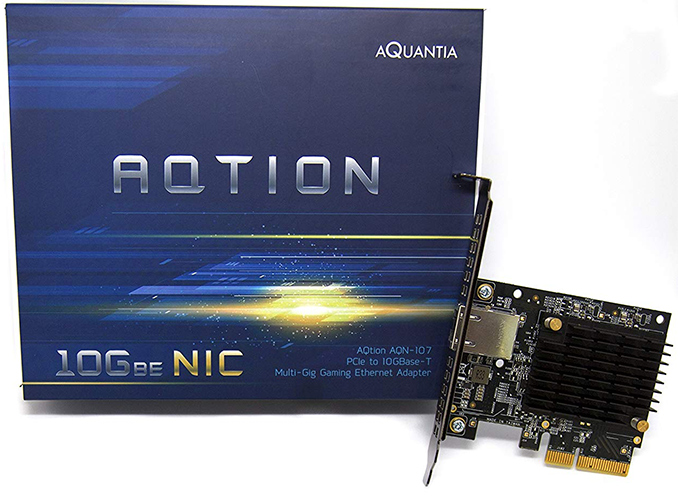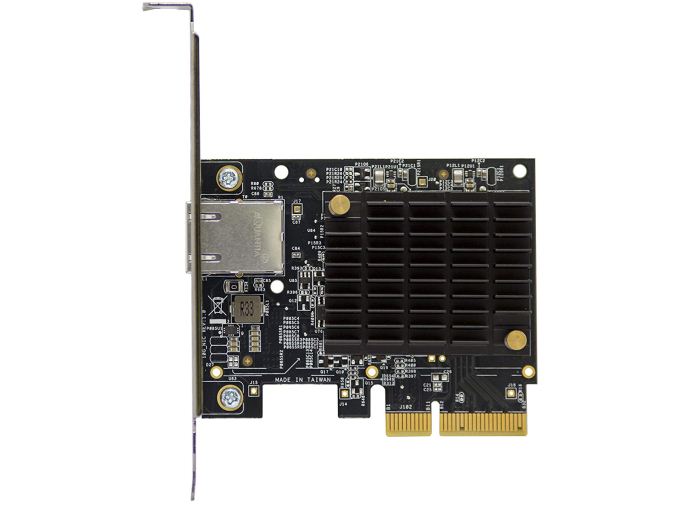Aquantia’s Gamer Edition AQtion AQN-107 10 GbE NIC Available
by Anton Shilov on July 12, 2018 2:00 PM EST
On Wednesday, Aquantia started to sell the gamer edition of its AQtion AQN-107 multi-gig network card. As the name implies, the 10 GbE NIC is aimed at demanding gamers as well as enthusiasts who are after the best network performance.
Aquantia’s gamer edition AQtion AQN-107 card is based on the company’s AQC107 (10 GbE) network controller that supports various BASE-T standards, including 100M, 1G, 2.5G, 5G, and 10G over an RJ45 connector using Cat5e/Cat6 cabling. The card uses a PCIe 3.0 x4 interface and comes on a black reference design PCB featuring an aluminum heat spreader that 'emphasizes' its gaming nature.
The key feature that differentiates gamer edition AQtion AQN-107 card from regular multi-gig network adapters from Aquantia is the company’s in-house developed gaming prioritization software. This will seem similar to the software tools offered by the Rivet Networks Killer network controllers, however both solutions approach the issue differently internally. Right now, Aquantia has three levels of prioritization supported by its software, but the company continues to work on this product.
Aquantia demonstrated a gaming rig outfitted with its AQtion AQN-107 card as well as the software at Computex. After trying the setup out, we can confirm that the software works and manages to reduce latency when priority modes are enabled and network traffic is being directed at mulitple sources.
The Aquantia Gamer Edition AQtion AQN-107 10 GbE network card is currently available from Amazon for $89.99.
The market of gaming PCs is not the most important one for Aquantia, especially in the light of the fact that there are virtually no affordable consumer-grade multi-gig switches. This partly explains why the card is currently available only from Amazon and why Aquantia is selling it under its own brand. In the meantime, it is evident that the company needs to address the market of demanding consumers with its 10 GbE offerings in a bid to establish itself a name among gamers to ensure successful competition against other multi-gig players in the future.
Related Reading
- Aquantia Multi-Gig: Single Chip USB 3.0 to 5G/2.5G Dongles Coming Soon
- Aquantia to Sell Its 5G and 10G Network Cards for $59 and $69 on Black Friday
- GIGABYTE’s GC-AQC107 10G Ethernet PCIe Card Launched and Listed
- ASUS Launches XG-C100C 10 GBase-T Adapter: Aquantia AQC107, $99
- Lower Cost 10GBase-T Switches Coming: 4, 5 and 8-port Aquantia Solutions at ~$30/Port
- Aquantia Launches New 2.5G/5G Multi-Gigabit Network Controllers for PCs
- Aquantia Launch AQtion 5G/2.5G/1G Multi-Gigabit Ethernet Cards (NICs) for PCIe
Source: Aquantia











31 Comments
View All Comments
Jhlot - Thursday, July 12, 2018 - link
Nice but where are the inexpensive 5-8 port 10gbe switches to go with it?CaedenV - Thursday, July 12, 2018 - link
I just need 2 ports, one for my desktop, and one for my home server... it will make video editing and converting sooooo much better when I can just run everything native from the server instead of needing to transfer local first!kgardas - Thursday, July 12, 2018 - link
So why do you not connect your desktop together with you server directly? Obviously you don't need any switch in your setup...DanNeely - Thursday, July 12, 2018 - link
Because he has more than 2 computers on his network, just that 3+ have much less pressing needs for faster connections.lightningz71 - Thursday, July 12, 2018 - link
Then go cable to cable from that PC to the server, setup RRAS services on the server to forward requests as needed, and use cheaper gear to connect the rest of the machines to the server.Gigaplex - Friday, July 13, 2018 - link
A 2-port switch won't give them the ability to connect to the other machines, though.azazel1024 - Friday, July 13, 2018 - link
What Lightningz71 suggested would do that. Or you can just play with the packet routing/route value a little on the machines and do a direct connect and each one can run a gig port to the switch which other machines connect to.But yes, ideally I'd like to see some inexpensive 8-24+2/4 switches that have 8-24 ports of GbE and 2-4 ports of 2.5, 5 or 10GbE to go along with. Preferably with some SFP+ slots also if I am going to have my cake and eat it too.
danielfranklin - Thursday, July 12, 2018 - link
It can be done now quite cheap.Pickup Intel X520 SFP+ NICs off ebay for well under $100, you can pickup 24 port switches with 4 10Gb ports for like $300 US, converted from Australian dollars which is usually overpriced...
FS.com sells the SFP and cables almost cheaper than a Cat6 cable from your local computer store...
Vatharian - Saturday, July 14, 2018 - link
I went this way, except I prefer Mellanox ConnectX 2 or 3 cards, pair can be had for $25-$30, and yes, fs.com 5m SFP+ 10G cable cost me something like $13 with shipping. For $300 pair of Mellanox ConnectX-4 with 40G or 100G can be had if such bandwidth is required, QSFP+ cable is little bit pricier ($20-30?), but that should suffice for everything.Switches, though... well, if you have to ask for price, you can't afford it.
I do have both computers hooked to a regular network, and only video, nfs and iscsi traffic goes trough 10G link - it's good enough.
You can also buy cheap 1G managed switch (used 24 port often can be had below $50) and grab a pair of 4x1G cards (here I suggest Intel cards), and configure teaming. It's not that much better, but still 400 MB/s is better than 100 MB/s.
dgingeri - Monday, July 16, 2018 - link
Teaming isn't very useful, since each stream is limited to just one link. So, max transfer rates would be limited to just 112MB/s, unless both machines were Windows 10 and/or Windows Server 2012r2 or 2016.NIC teaming is useful for servers where multiple workstations are accessing resources at once or between switches where multiple streams are going between them, but for single point to point, it does not enhance performance, as it only allows a connection between 2 endpoints to use one single link. This is the case with both software (Round Robin) and hardware (LACP) methods.
However, with Windows 10 and Windows Server 2012r2 and up, It does allow for each file or session being transferred to go across a different link, so 2 4 NIC teams could copy bunches of files much faster than a single link, but each individual stream is still limited to just one link, so a single file copy or a streamed video would still be limited to 112MB/s.